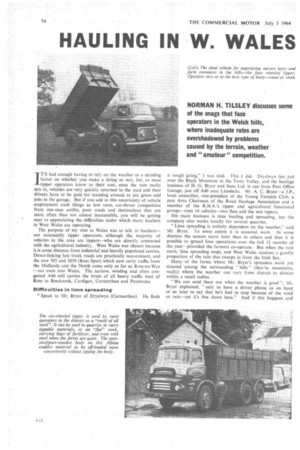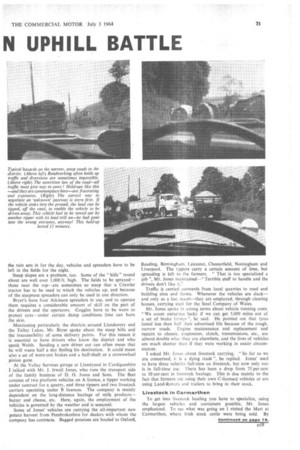HAULING IN W. WALES N UPHILL BATTLE
Page 76

Page 77

If you've noticed an error in this article please click here to report it so we can fix it.
NORMAN H. TILSLEY discusses some of the snags that face operators in the Welsh hills, where inadequate rates are overshadowed by problems caused by the terrain, weather and " amateur " competition.
I .• TS bad enough having to rely on the weather as a deciding factor on whether you make a living or not.;, for, as most
tipper operators know to their cost, once the rain really Sets in, vehicles are very quickly returned to the yard and their drivers have to be paid for standing around or are given odd jobs in the garage,. But if you add to this uncertainty of vehicle employment such things as low rates, cut-throat competition from one-man outfits, poor roads and destinations that are more 'often than not almost inaccessible, you will be getting near to appreciating the difficulties Under which many hauliers in West Wales are operating.
The purpose of my visit to Wales was to talk to hauliers— not necessarily tipper operators, although the majority of vehicles in the area are tippers—who are directly connected with the agricultural industry. West Wales. was chosen because it is some distance from industrial and heavily populated centres. Direct-linking fast trunk.roads are practically non-existent, and the new MS and M50 (Ross Spur) which now carry traffic from the Midlands and the North come only as far as Ross-on-Wye —not even into Wales. The narrow, winding and often congested A40 still carries the brunt of all heavy traffic west of Ross to Brecknock, Cardigan, Carmarthen and Pembroke.
Difficulties in lime spreading
"Speak to Mr. Bryer of Dryslwyn (Carmarthen). He finds it rough going," I was told. This I did. Dryslwyn lies just over the Black Mountain in the Towy Valley, and the haulage business of H. G. Bryer and Sons LW. is run from Post Office Garage, just off A40 near Llandeilo. Mr. A. C. Bryer—a J.P., local eouneiller, vice-president of the Young Farmers Club, a past Area Chairman of the Road Haulage Association and a member of the R.H.A.'s tipper and agricultural functional groups—runs 16 vehicles—two flats and the rest tippers.
His main business is lime hauling and spreading, but the company also works locally for several quarries.
" Lime spreading is entirely dependent on the weather," said Mr. Bryer, To some extent it is seasonal work. In some districts the season starts later than in others and thus it is possible to spread lime operations over the full 12 months of the year—pirovided the farmers co-operate. But when the rain starts, lime spreading stops, and West Wales receives a goodly proportion of the rain that sweeps in from the Irish Sea.
Many of the farms where Mr. 13ryer's spreaders work arc situated among the surrounding " hills " (they're mountains, really) where the weather can vary from district to district within a small radius.
"We can send them out when the weather is good ", Mr. Bryer explained, " only to have a driver phone us an hour or so later to say that he's had to stop because of the wind or rain—yet, it's fine down here." And if this happens and the rain sets in for the day, vehicles and spreaders have to be left in the fields for the night. , Steep slopes are a problem, too. Some of the " hills " round about are well over 1,000 ft. high. The fields to be sprayed— those near the top—are sometimes so steep that a Crawler tractor has to be used to winch the vehicles up, and because of the steepness spreaders can only be used in one direction.
Bryer's have four Atkinson spreaders in use, and to operate them requires a considerable amount of skill on the part of the .drivers and the operators. Goggles have to be worn to protect eyes—under certain damp conditions lime can burn the skin.
Mentioning particularly the• districts around Llandovery and the Talley Lakes, Mr. Bryer spoke about the steep hills and the inaccessibility of some delivery points. For this reason it is essential to have drivers who know the district and who speak Welsh. Sending a new driver out can often mean that he will waste half a day finding his destination. It could mean also a set of worn-out brakes and a half-shaft or a crownwheel pinion gone.
At the Valley Services garage at Llandyssul in Cardiganshire I talked with Mr. J. Irwell Jones, who runs the transport side of the family business of D. 0. Jones and Sons. The fleet consists of two platform vehicles on A licence, a tipper working under contract for a•quarry, and three tippers and two livestock carriers operating under B licences. The company is mainly dependent on the long-distance haulage of milk products— butter and cheese, etc. Here, again, the employment of the vehicles is governed by the weather and is seasonal.
Some of Jones' vehicles are carrying the all-important new potato harvest from Pembrokeshire for dealers with whom the company has contracts. Bagged potatoes are hauled to Oxford. Reading, Birmingham, Leicester, Chesterfield, Nottingham and Liverpool. The tippers carry a certain amount of lime, but spreading is left to the farmers. " That is too specialized a job ", Mr. Jones maintained—" Terrible stuff to handle and the drivers don't like it."
Traffic is carried outwards from local quarries to road and building sites and farms. Whenever the vehicles are slack— and only as a last resort—they are employed, through clearing houses, carrying steel for the Steel Company of Wales.
Mr. Jones spoke in strong terms about vehicle running costs. "We count ourselves lucky if we can get 5,000 miles out of a set of brake lin;ngs ", he said. He pointed out that tyres lasted less than half their advertised life because of the rough, narrow roads. Engine maintenance and replacement and repairs to chassis, suspension, clutch, transmissions, etc., are almost double what they are elsewhere, and the lives of vehicles are much shorter than if they were working in easier circumstances.
I asked Mr. Jones about livestock carrying. "So far as we are concerned, it is a dying trade ", he replied. Jones' used to have three vehicles full-time on livestock, but now only one is in full-time use. There has been a drop from 75 per cent to 10 per cent in livestock haulage. This is due mainly to the fact that farmers are using their own C-licensed vehicles or are using Land-Rovers and trailers to bring in their stock.
Livestock in Carmarthen
To get into livestock hauling you have to specialize, using the largest vehicles and containers possible, Mr. Jones emphasized. To see what was going on I visited the Mart at Carmarthen, where Irish stock cattle were being sold. By Continued on page 79. D19












































































































































